Protein Expression Analysis of an In Vitro Murine Model of Prostate Cancer Progression: Towards Identification of High-Potential Therapeutic Targets
Abstract
1. Introduction
2. Materials and Methods
2.1. Cell Lines, Culture Conditions, and Reagents
2.2. Protein Extraction, Denaturation, and Digestion
2.3. Liquid Chromatography (LC)–Mass Spectrometer (MS)/MS Analysis
2.4. Protein Identification and Quantification
2.5. Bioinformatics Analysis of the Differentially Abundant Proteins
2.6. Western Blot Analysis
2.7. Statistical Analysis
3. Results
3.1. Protein Expression Profiles of PLum-AI vs. PLum-AD Cell Lines
3.2. Unsupervised Principal Component Analysis (PCA)
3.3. Validation of Some of the Differentially Expressed Proteins in PLum-AI vs. PLum-AD Cells
3.4. Construction of the Protein–Protein Interaction (PPI) Network Associated with the Differentially Expressed Proteins in PLum-AI vs. PLum-AD Cells
3.5. Subnetwork Analyses of Pathways Associated with the Differentially Expressed Proteins in PLum-AI vs. PLum-AD Cells
4. Discussion
5. Conclusions
Supplementary Materials
Author Contributions
Funding
Acknowledgments
Conflicts of Interest
References
- Siegel, R.L.; Miller, K.D.; Jemal, A. Cancer statistics. CA A Cancer J. Clin. 2020, 70, 7–30. [Google Scholar] [CrossRef] [PubMed]
- Shahait, M.; Mukherji, D.; Hamieh, N.; Nassif, S.; Jabbour, M.; Khauli, R.; Bulbul, M.; Abou Kheir, W.; El Hajj, A. Second primary malignancy after radical prostatectomy in a cohort from the Middle East. Prostate Int. 2018, 6, 46–49. [Google Scholar] [CrossRef] [PubMed]
- Wen, S.; Chang, H.C.; Tian, J.; Shang, Z.; Niu, Y.; Chang, C. Stromal androgen receptor roles in the development of normal prostate, benign prostate hyperplasia, and prostate cancer. Am. J. Pathol. 2015, 185, 293–301. [Google Scholar] [CrossRef] [PubMed]
- Heinlein, C.A.; Chang, C. Androgen Receptor in Prostate Cancer. Endocr. Rev. 2004, 25, 276–308. [Google Scholar] [CrossRef]
- Crawford, E.D.; Heidenreich, A.; Lawrentschuk, N.; Tombal, B.; Pompeo, A.C.L.; Mendoza-Valdes, A.; Miller, K.; Debruyne, F.M.J.; Klotz, L. Androgen-targeted therapy in men with prostate cancer: Evolving practice and future considerations. Prostate Cancer Prostatic Dis. 2019, 22, 24–38. [Google Scholar] [CrossRef]
- Tan, M.H.E.; Li, J.; Xu, H.E.; Melcher, K.; Yong, E.-L. Androgen receptor: Structure, role in prostate cancer and drug discovery. Acta Pharm. Sin. 2015, 36, 3–23. [Google Scholar] [CrossRef]
- Saranyutanon, S.; Srivastava, S.K.; Pai, S.; Singh, S.; Singh, A.P. Therapies Targeted to Androgen Receptor Signaling Axis in Prostate Cancer: Progress, Challenges, and Hope. Cancers 2020, 12, 51. [Google Scholar] [CrossRef]
- Tsai, Y.C.; Chen, W.Y.; Abou-Kheir, W.; Zeng, T.; Yin, J.J.; Bahmad, H.; Lee, Y.C.; Liu, Y.N. Androgen deprivation therapy-induced epithelial-mesenchymal transition of prostate cancer through downregulating SPDEF and activating CCL2. Biochim. Et Biophys. Acta Mol. Basis Dis. 2018, 1864, 1717–1727. [Google Scholar] [CrossRef]
- Fujita, K.; Nonomura, N. Role of Androgen Receptor in Prostate Cancer: A Review. World J. Mens. Health 2019, 37, 288–295. [Google Scholar] [CrossRef]
- Pienta, K.J.; Bradley, D. Mechanisms Underlying the Development of Androgen-Independent Prostate Cancer. Clin. Cancer Res. 2006, 12, 1665–1671. [Google Scholar] [CrossRef]
- Bahmad, H.F.; Samman, H.; Monzer, A.; Hadadeh, O.; Cheaito, K.; Abdel-Samad, R.; Hayar, B.; Pisano, C.; Msheik, H.; Liu, Y.N.; et al. The synthetic retinoid ST1926 attenuates prostate cancer growth and potentially targets prostate cancer stem-like cells. Mol. Carcinog. 2019, 58, 1208–1220. [Google Scholar] [CrossRef] [PubMed]
- Daoud, G.; Monzer, A.; Bahmad, H.; Chamaa, F.; Hamdar, L.; Mouhieddine, T.H.; Shayya, S.; Eid, A.; Kobeissy, F.; Liu, Y.N.; et al. Primary versus castration-resistant prostate cancer: Modeling through novel murine prostate cancer cell lines. Oncotarget 2016, 7, 28961–28975. [Google Scholar] [CrossRef] [PubMed]
- Agarwal, S.; Hynes, P.G.; Tillman, H.S.; Lake, R.; Abou-Kheir, W.G.; Fang, L.; Casey, O.M.; Ameri, A.H.; Martin, P.L.; Yin, J.J.; et al. Identification of Different Classes of Luminal Progenitor Cells within Prostate Tumors. Cell Rep. 2015, 13, 2147–2158. [Google Scholar] [CrossRef] [PubMed]
- Cattrini, C.; Castro, E.; Lozano, R.; Zanardi, E.; Rubagotti, A.; Boccardo, F.; Olmos, D. Current Treatment Options for Metastatic Hormone-Sensitive Prostate Cancer. Cancers 2019, 11, 1355. [Google Scholar] [CrossRef]
- Madu, C.O.; Lu, Y. Novel diagnostic biomarkers for prostate cancer. J. Cancer 2010, 1, 150–177. [Google Scholar] [CrossRef]
- Shahait, M.; Nassif, S.; Tamim, H.; Mukherji, D.; Hijazi, M.; El Sabban, M.; Khauli, R.; Bulbul, M.; Abou Kheir, W.; El Hajj, A. Ki-67 expression predicts biochemical recurrence after radical prostatectomy in the setting of positive surgical margins. BMC Urol. 2018, 18, 13. [Google Scholar] [CrossRef]
- Cheaito, K.A.; Bahmad, H.F.; Hadadeh, O.; Saleh, E.; Dagher, C.; Hammoud, M.S.; Shahait, M.; Mrad, Z.A.; Nassif, S.; Tawil, A.; et al. EMT Markers in Locally-Advanced Prostate Cancer: Predicting Recurrence? Front. Oncol. 2019, 9, 131. [Google Scholar] [CrossRef]
- Quinn, D.I.; Henshall, S.M.; Haynes, A.-M.; Brenner, P.C.; Kooner, R.; Golovsky, D.; Mathews, J.; O’Neill, G.F.; Turner, J.J.; Delprado, W. Prognostic significance of pathologic features in localized prostate cancer treated with radical prostatectomy: Implications for staging systems and predictive models. J. Clin. Oncol. 2001, 19, 3692–3705. [Google Scholar] [CrossRef]
- Karakiewicz, P.I.; Eastham, J.A.; Graefen, M.; Cagiannos, I.; Stricker, P.D.; Klein, E.; Cangiano, T.; Schröder, F.H.; Scardino, P.T.; Kattan, M.W. Prognostic impact of positive surgical margins in surgically treated prostate cancer: Multi-institutional assessment of 5831 patients. Urology 2005, 66, 1245–1250. [Google Scholar] [CrossRef]
- Wright, J.L.; Dalkin, B.L.; True, L.D.; Ellis, W.J.; Stanford, J.L.; Lange, P.H.; Lin, D.W. Positive surgical margins at radical prostatectomy predict prostate cancer specific mortality. J. Urol. 2010, 183, 2213–2218. [Google Scholar] [CrossRef]
- Carvalhal, G.F.; Daudi, S.N.; Kan, D.; Mondo, D.; Roehl, K.A.; Loeb, S.; Catalona, W.J. Correlation between serum prostate-specific antigen and cancer volume in prostate glands of different sizes. Urology 2010, 76, 1072–1076. [Google Scholar] [CrossRef] [PubMed]
- Lu, M.; Zhan, X. The crucial role of multiomic approach in cancer research and clinically relevant outcomes. EPMA J. 2018, 9, 77–102. [Google Scholar] [CrossRef] [PubMed]
- Latonen, L.; Afyounian, E.; Jylhä, A.; Nättinen, J.; Aapola, U.; Annala, M.; Kivinummi, K.K.; Tammela, T.T.L.; Beuerman, R.W.; Uusitalo, H.; et al. Integrative proteomics in prostate cancer uncovers robustness against genomic and transcriptomic aberrations during disease progression. Nat. Commun. 2018, 9, 1176. [Google Scholar] [CrossRef] [PubMed]
- Abou-Abbass, H.; Abou-El-Hassan, H.; Bahmad, H.; Zibara, K.; Zebian, A.; Youssef, R.; Ismail, J.; Zhu, R.; Zhou, S.; Dong, X.; et al. Glycosylation and other PTMs alterations in neurodegenerative diseases: Current status and future role in neurotrauma. Electrophoresis 2016, 37, 1549–1561. [Google Scholar] [CrossRef]
- Abou-Abbass, H.; Bahmad, H.; Abou-El-Hassan, H.; Zhu, R.; Zhou, S.; Dong, X.; Hamade, E.; Mallah, K.; Zebian, A.; Ramadan, N.; et al. Deciphering glycomics and neuroproteomic alterations in experimental traumatic brain injury: Comparative analysis of aspirin and clopidogrel treatment. Electrophoresis 2016, 37, 1562–1576. [Google Scholar] [CrossRef]
- Alaaeddine, R.; Fayad, M.; Nehme, E.; Bahmad, H.F.; Kobeissy, F. The Emerging Role of Proteomics in Precision Medicine: Applications in Neurodegenerative Diseases and Neurotrauma. Adv. Exp. Med. Biol. 2017, 1007, 59–70. [Google Scholar] [CrossRef]
- Jaber, Z.; Aouad, P.; Al Medawar, M.; Bahmad, H.; Abou-Abbass, H.; Ghandour, H.; Mondello, S.; Kobeissy, F. Role of Systems Biology in Brain Injury Biomarker Discovery: Neuroproteomics Application. Methods Mol. Biol. (Clifton N. J.) 2016, 1462, 157–174. [Google Scholar] [CrossRef]
- Jaber, Z.; Aouad, P.; Al Medawar, M.; Bahmad, H.; Abou-Abbass, H.; Kobeissy, F. Application of Systems Biology to Neuroproteomics: The Path to Enhanced Theranostics in Traumatic Brain Injury. Methods Mol. Biol. (Clifton N. J.) 2016, 1462, 139–155. [Google Scholar] [CrossRef]
- Kobeissy, F.H.; Guingab-Cagmat, J.D.; Zhang, Z.; Moghieb, A.; Glushakova, O.Y.; Mondello, S.; Boutté, A.M.; Anagli, J.; Rubenstein, R.; Bahmad, H.; et al. Neuroproteomics and Systems Biology Approach to Identify Temporal Biomarker Changes Post Experimental Traumatic Brain Injury in Rats. Front. Neurol. 2016, 7, 198. [Google Scholar] [CrossRef]
- Abou-El-Hassan, H.; Sukhon, F.; Assaf, E.J.; Bahmad, H.; Abou-Abbass, H.; Jourdi, H.; Kobeissy, F.H. Degradomics in Neurotrauma: Profiling Traumatic Brain Injury. Methods Mol. Biol. (Clifton N. J.) 2017, 1598, 65–99. [Google Scholar] [CrossRef]
- Duarte, T.T.; Spencer, C.T. Personalized Proteomics: The Future of Precision Medicine. Proteomes 2016, 4, 29. [Google Scholar] [CrossRef] [PubMed]
- Gulcicek, E.E.; Colangelo, C.M.; McMurray, W.; Stone, K.; Williams, K.; Wu, T.; Zhao, H.; Spratt, H.; Kurosky, A.; Wu, B. Proteomics and the analysis of proteomic data: An overview of current protein-profiling technologies. Curr. Protoc. Bioinform. 2005. [Google Scholar] [CrossRef] [PubMed]
- Peng, W.; Zhang, Y.; Zhu, R.; Mechref, Y. Comparative membrane proteomics analyses of breast cancer cell lines to understand the molecular mechanism of breast cancer brain metastasis. Electrophoresis 2017, 38, 2124–2134. [Google Scholar] [CrossRef]
- Szklarczyk, D.; Franceschini, A.; Wyder, S.; Forslund, K.; Heller, D.; Huerta-Cepas, J.; Simonovic, M.; Roth, A.; Santos, A.; Tsafou, K.P.; et al. STRING v10: Protein-protein interaction networks, integrated over the tree of life. Nucleic Acids Res. 2015, 43, D447–D452. [Google Scholar] [CrossRef] [PubMed]
- Bonnet, A.; Lagarrigue, S.; Liaubet, L.; Robert-Granié, C.; Sancristobal, M.; Tosser-Klopp, G. Pathway results from the chicken data set using GOTM, Pathway Studio and Ingenuity softwares. BMC Proc. 2009, 3, S11. [Google Scholar] [CrossRef]
- Yuryev, A.; Kotelnikova, E.; Daraselia, N. Ariadne′s ChemEffect and Pathway Studio knowledge base. Expert Opin. Drug Discov. 2009, 4, 1307–1318. [Google Scholar] [CrossRef]
- Abdi, H.; Williams, L.J. Principal component analysis. Wiley Interdiscip. Rev. Comput. Stat. 2010, 2, 433–459. [Google Scholar] [CrossRef]
- Abou-Kheir, W.; Hynes, P.G.; Martin, P.; Yin, J.J.; Liu, Y.-N.; Seng, V.; Lake, R.; Spurrier, J.; Kelly, K. Self-Renewing Pten-/-TP53-/- Protospheres Produce Metastatic Adenocarcinoma Cell Lines with Multipotent Progenitor Activity. PLoS ONE 2011, 6, e26112. [Google Scholar] [CrossRef]
- Abou-Kheir, W.G.; Hynes, P.G.; Martin, P.L.; Pierce, R.; Kelly, K. Characterizing the contribution of stem/progenitor cells to tumorigenesis in the Pten-/-TP53-/- prostate cancer model. Stem. Cells (Dayt. Ohio) 2010, 28, 2129–2140. [Google Scholar] [CrossRef]
- Zhang, K.; Zhou, S.; Wang, L.; Wang, J.; Zou, Q.; Zhao, W.; Fu, Q.; Fang, X. Current Stem Cell Biomarkers and Their Functional Mechanisms in Prostate Cancer. Int. J. Mol. Sci. 2016, 17, 1163. [Google Scholar] [CrossRef]
- Shen, M.M.; Abate-Shen, C. Molecular genetics of prostate cancer: New prospects for old challenges. Genes. Dev. 2010, 24, 1967–2000. [Google Scholar] [CrossRef]
- Bahmad, H.F.; Cheaito, K.; Chalhoub, R.M.; Hadadeh, O.; Monzer, A.; Ballout, F.; El-Hajj, A.; Mukherji, D.; Liu, Y.-N.; Daoud, G.; et al. Sphere-Formation Assay: Three-Dimensional in vitro Culturing of Prostate Cancer Stem/Progenitor Sphere-Forming Cells. Front Oncol 2018, 8, 347. [Google Scholar] [CrossRef] [PubMed]
- Zhao, J.; Li, J.; Fan, T.W.M.; Hou, S.X. Glycolytic reprogramming through PCK2 regulates tumor initiation of prostate cancer cells. Oncotarget 2017, 8, 83602–83618. [Google Scholar] [CrossRef] [PubMed]
- Clark, D.W.; Palle, K. Aldehyde dehydrogenases in cancer stem cells: Potential as therapeutic targets. Ann. Transl. Med. 2016, 4, 518. [Google Scholar] [CrossRef] [PubMed]
- Li, T.; Su, Y.; Mei, Y.; Leng, Q.; Leng, B.; Liu, Z.; Stass, S.A.; Jiang, F. ALDH1A1 is a marker for malignant prostate stem cells and predictor of prostate cancer patients’ outcome. Lab. Investig. A J. Tech. Methods Pathol. 2010, 90, 234–244. [Google Scholar] [CrossRef] [PubMed]
- Yu, C.; Yao, Z.; Jiang, Y.; Keller, E.T. Prostate cancer stem cell biology. Minerva Urol. E Nefrol. Ital. J. Urol. Nephrol. 2012, 64, 19–33. [Google Scholar]
- Dubrovska, A.; Kim, S.; Salamone, R.J.; Walker, J.R.; Maira, S.M.; García-Echeverría, C.; Schultz, P.G.; Reddy, V.A. The role of PTEN/Akt/PI3K signaling in the maintenance and viability of prostate cancer stem-like cell populations. Proc. Natl. Acad. Sci. USA 2009, 106, 268–273. [Google Scholar] [CrossRef]
- Li, L.; Lou, Z.; Wang, L. The role of FKBP5 in cancer aetiology and chemoresistance. Br. J. Cancer 2011, 104, 19–23. [Google Scholar] [CrossRef]
- Suzuki, M.; Kurosaki, T.; Arai, T.; Sawabe, M.; Hosoi, T.; Kitamura, T. The Val158Met polymorphism of the catechol-O-methyltransferase gene is not associated with the risk of sporadic or latent prostate cancer in Japanese men. Int. J. Urol. 2007, 14, 800–804. [Google Scholar] [CrossRef]
- Suzuki, K.; Nakazato, H.; Matsui, H.; Koike, H.; Okugi, H.; Kashiwagi, B.; Nishii, M.; Ohtake, N.; Nakata, S.; Ito, K.; et al. Genetic polymorphisms of estrogen receptor alpha, CYP19, catechol-O-methyltransferase are associated with familial prostate carcinoma risk in a Japanese population. Cancer 2003, 98, 1411–1416. [Google Scholar] [CrossRef]
- Chao, Y.; Wu, Q.; Acquafondata, M.; Dhir, R.; Wells, A. Partial mesenchymal to epithelial reverting transition in breast and prostate cancer metastases. Cancer Microenviron. Off. J. Int. Cancer Microenviron. Soc. 2012, 5, 19–28. [Google Scholar] [CrossRef] [PubMed]
- Liu, Y.N.; Abou-Kheir, W.; Yin, J.J.; Fang, L.; Hynes, P.; Casey, O.; Hu, D.; Wan, Y.; Seng, V.; Sheppard-Tillman, H.; et al. Critical and reciprocal regulation of KLF4 and SLUG in transforming growth factor β-initiated prostate cancer epithelial-mesenchymal transition. Mol. Cell. Biol. 2012, 32, 941–953. [Google Scholar] [CrossRef] [PubMed]
- Nawshad, A.; Lagamba, D.; Polad, A.; Hay, E.D. Transforming growth factor-beta signaling during epithelial-mesenchymal transformation: Implications for embryogenesis and tumor metastasis. Cells Tissues Organs 2005, 179, 11–23. [Google Scholar] [CrossRef] [PubMed]
- Kalluri, R.; Weinberg, R.A. The basics of epithelial-mesenchymal transition. J. Clin. Investig. 2009, 119, 1420–1428. [Google Scholar] [CrossRef] [PubMed]
- Grant, C.M.; Kyprianou, N. Epithelial mesenchymal transition (EMT) in prostate growth and tumor progression. Transl. Androl. Urol. 2013, 2, 202–211. [Google Scholar] [CrossRef] [PubMed]
- Lo, U.G.; Lee, C.-F.; Lee, M.-S.; Hsieh, J.-T. The Role and Mechanism of Epithelial-to-Mesenchymal Transition in Prostate Cancer Progression. Int. J. Mol. Sci. 2017, 18, 2079. [Google Scholar] [CrossRef]
- Chen, C.L.; Mahalingam, D.; Osmulski, P.; Jadhav, R.R.; Wang, C.M.; Leach, R.J.; Chang, T.C.; Weitman, S.D.; Kumar, A.P.; Sun, L.; et al. Single-cell analysis of circulating tumor cells identifies cumulative expression patterns of EMT-related genes in metastatic prostate cancer. Prostate 2013, 73, 813–826. [Google Scholar] [CrossRef]
- Tsai, Y.C.; Zeng, T.; Abou-Kheir, W.; Yeh, H.L.; Yin, J.J.; Lee, Y.C.; Chen, W.Y.; Liu, Y.N. Disruption of ETV6 leads to TWIST1-dependent progression and resistance to epidermal growth factor receptor tyrosine kinase inhibitors in prostate cancer. Mol. Cancer 2018, 17, 42. [Google Scholar] [CrossRef]
- Nguyen, D.P.; Li, J.; Tewari, A.K. Inflammation and prostate cancer: The role of interleukin 6 (IL-6). BJU Int. 2014, 113, 986–992. [Google Scholar] [CrossRef]
- Rojas, A.; Liu, G.; Coleman, I.; Nelson, P.S.; Zhang, M.; Dash, R.; Fisher, P.B.; Plymate, S.R.; Wu, J.D. IL-6 promotes prostate tumorigenesis and progression through autocrine cross-activation of IGF-IR. Oncogene 2011, 30, 2345–2355. [Google Scholar] [CrossRef]
- Sun, F.; Chen, H.G.; Li, W.; Yang, X.; Wang, X.; Jiang, R.; Guo, Z.; Chen, H.; Huang, J.; Borowsky, A.D.; et al. Androgen receptor splice variant AR3 promotes prostate cancer via modulating expression of autocrine/paracrine factors. J. Biol. Chem. 2014, 289, 1529–1539. [Google Scholar] [CrossRef] [PubMed]
- Xu, J.; Qiu, Y. Role of androgen receptor splice variants in prostate cancer metastasis. Asian J. Urol. 2016, 3, 177–184. [Google Scholar] [CrossRef] [PubMed]
- Huang, Y.; Jin, C.; Hamana, T.; Liu, J.; Wang, C.; An, L.; McKeehan, W.L.; Wang, F. Overexpression of FGF9 in prostate epithelial cells augments reactive stroma formation and promotes prostate cancer progression. Int. J. Biol. Sci. 2015, 11, 948–960. [Google Scholar] [CrossRef] [PubMed]
- Yang, Y.; Jiao, L.; Hou, J.; Xu, C.; Wang, L.; Yu, Y.; Li, Y.; Yang, C.; Wang, X.; Sun, Y. Dishevelled-2 silencing reduces androgen-dependent prostate tumor cell proliferation and migration and expression of Wnt-3a and matrix metalloproteinases. Mol. Biol. Rep. 2013, 40, 4241–4250. [Google Scholar] [CrossRef]
- Baruah, M.M.; Khandwekar, A.P.; Sharma, N. Quercetin modulates Wnt signaling components in prostate cancer cell line by inhibiting cell viability, migration, and metastases. Tumour Biol. 2016, 37, 14025–14034. [Google Scholar] [CrossRef]
- Darnel, A.D.; Behmoaram, E.; Vollmer, R.T.; Corcos, J.; Bijian, K.; Sircar, K.; Su, J.; Jiao, J.; Alaoui-Jamali, M.A.; Bismar, T.A. Fascin regulates prostate cancer cell invasion and is associated with metastasis and biochemical failure in prostate cancer. Clin. Cancer Res. An Off. J. Am. Assoc. Cancer Res. 2009, 15, 1376–1383. [Google Scholar] [CrossRef]
- Kumar-Sinha, C.; Chinnaiyan, A.M. Molecular markers to identify patients at risk for recurrence after primary treatment for prostate cancer. Urology 2003, 62, 19–35. [Google Scholar] [CrossRef]
- Varambally, S.; Yu, J.; Laxman, B.; Rhodes, D.R.; Mehra, R.; Tomlins, S.A.; Shah, R.B.; Chandran, U.; Monzon, F.A.; Becich, M.J.; et al. Integrative genomic and proteomic analysis of prostate cancer reveals signatures of metastatic progression. Cancer Cell 2005, 8, 393–406. [Google Scholar] [CrossRef]

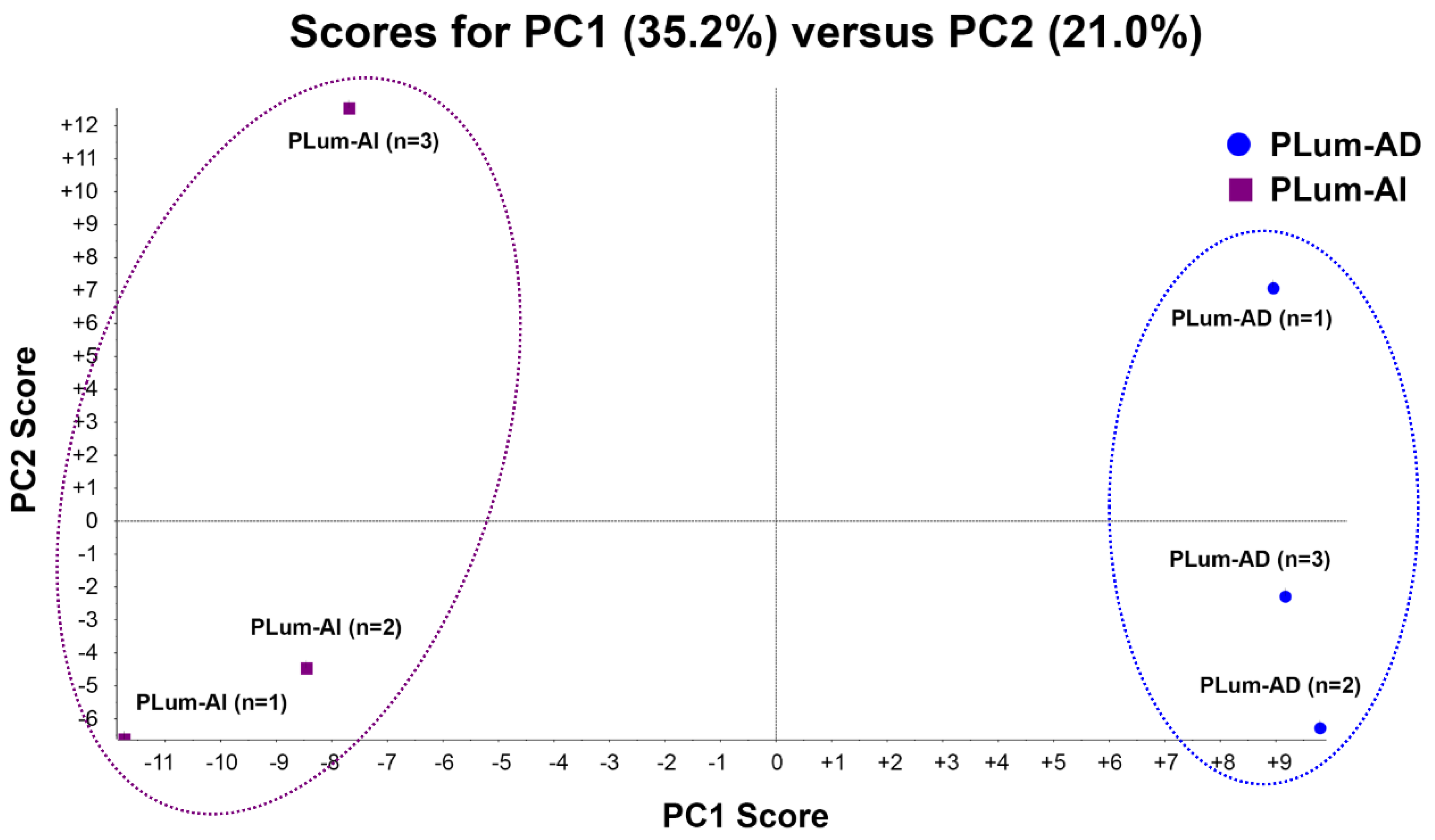
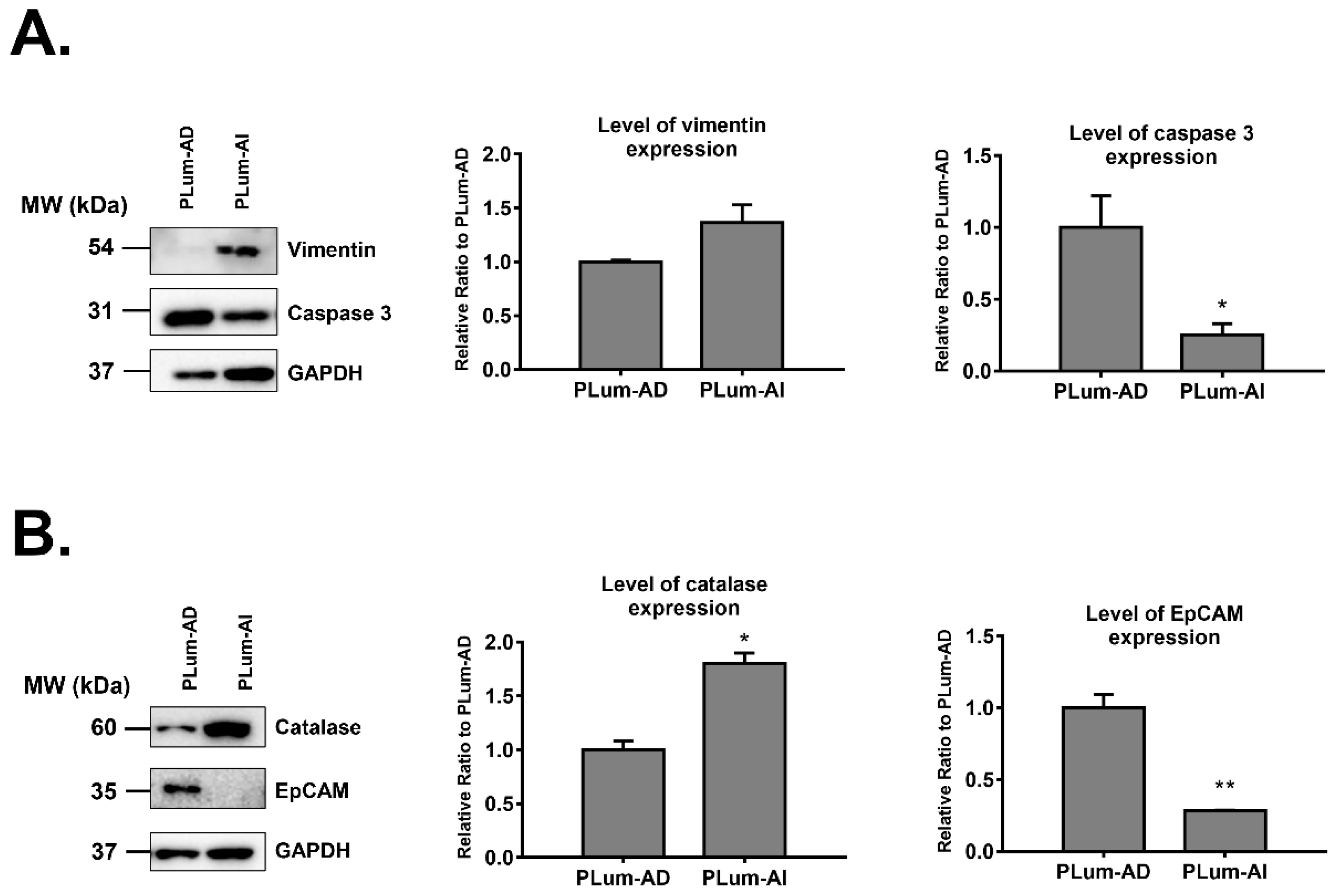
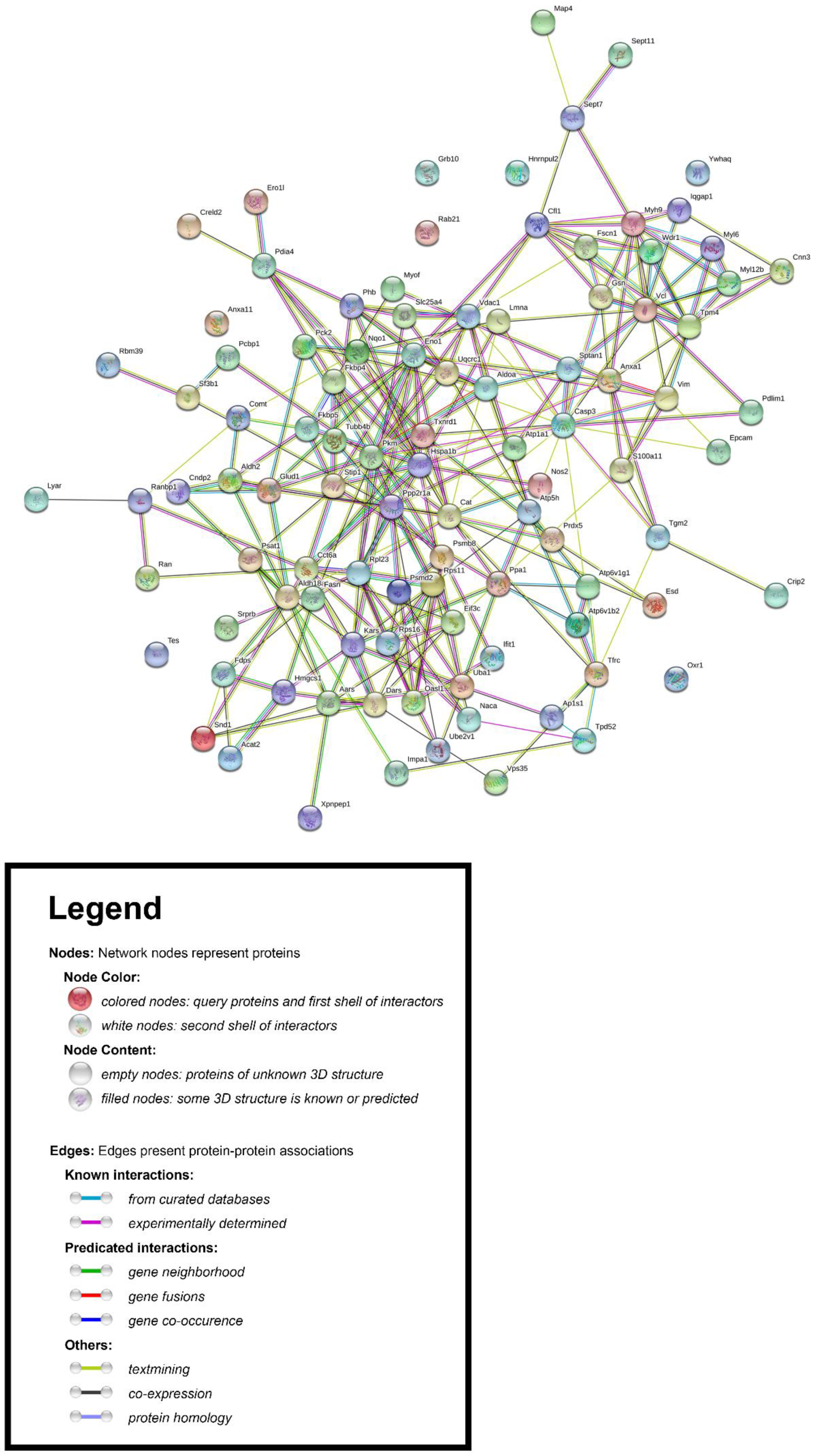
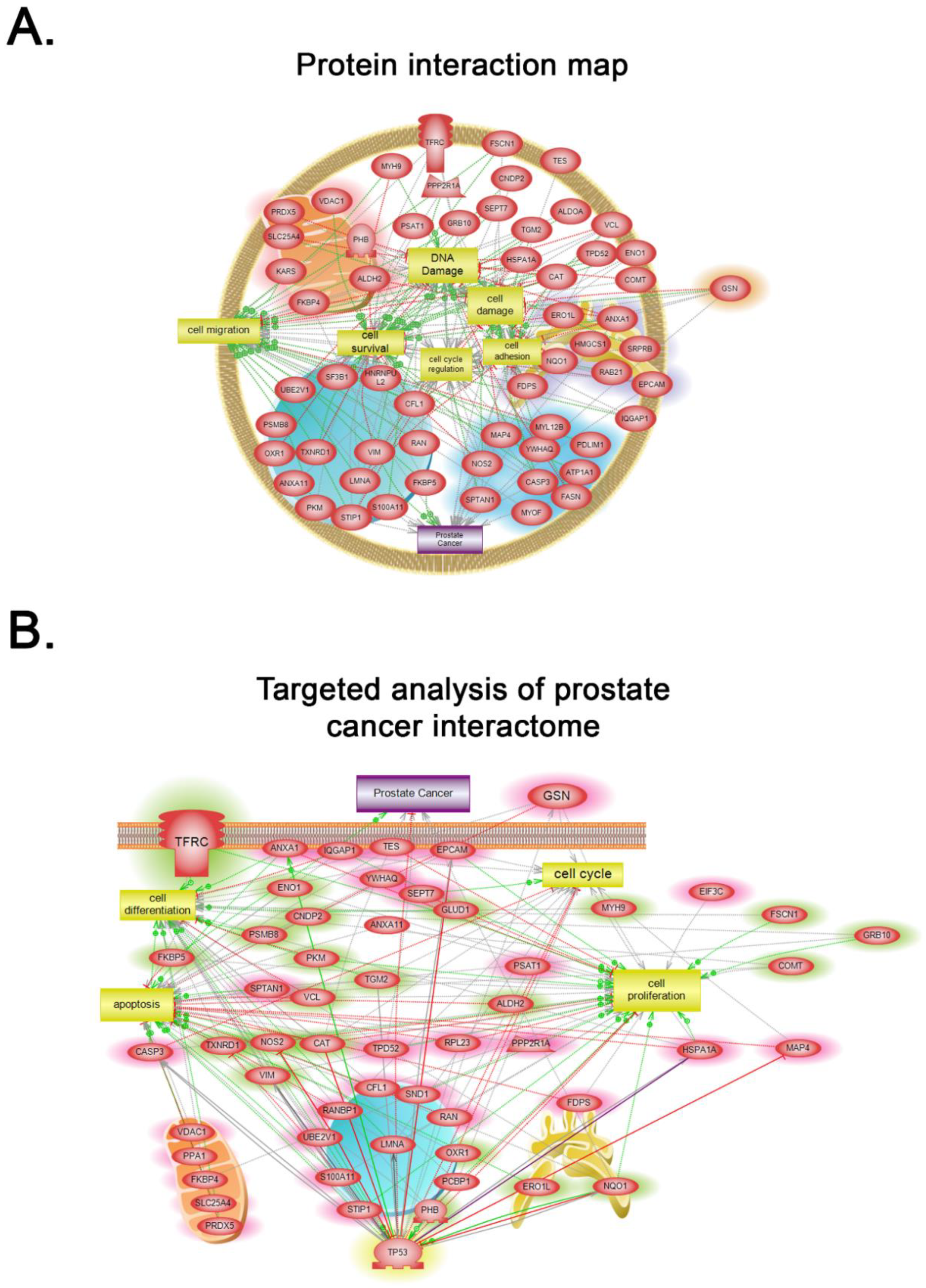
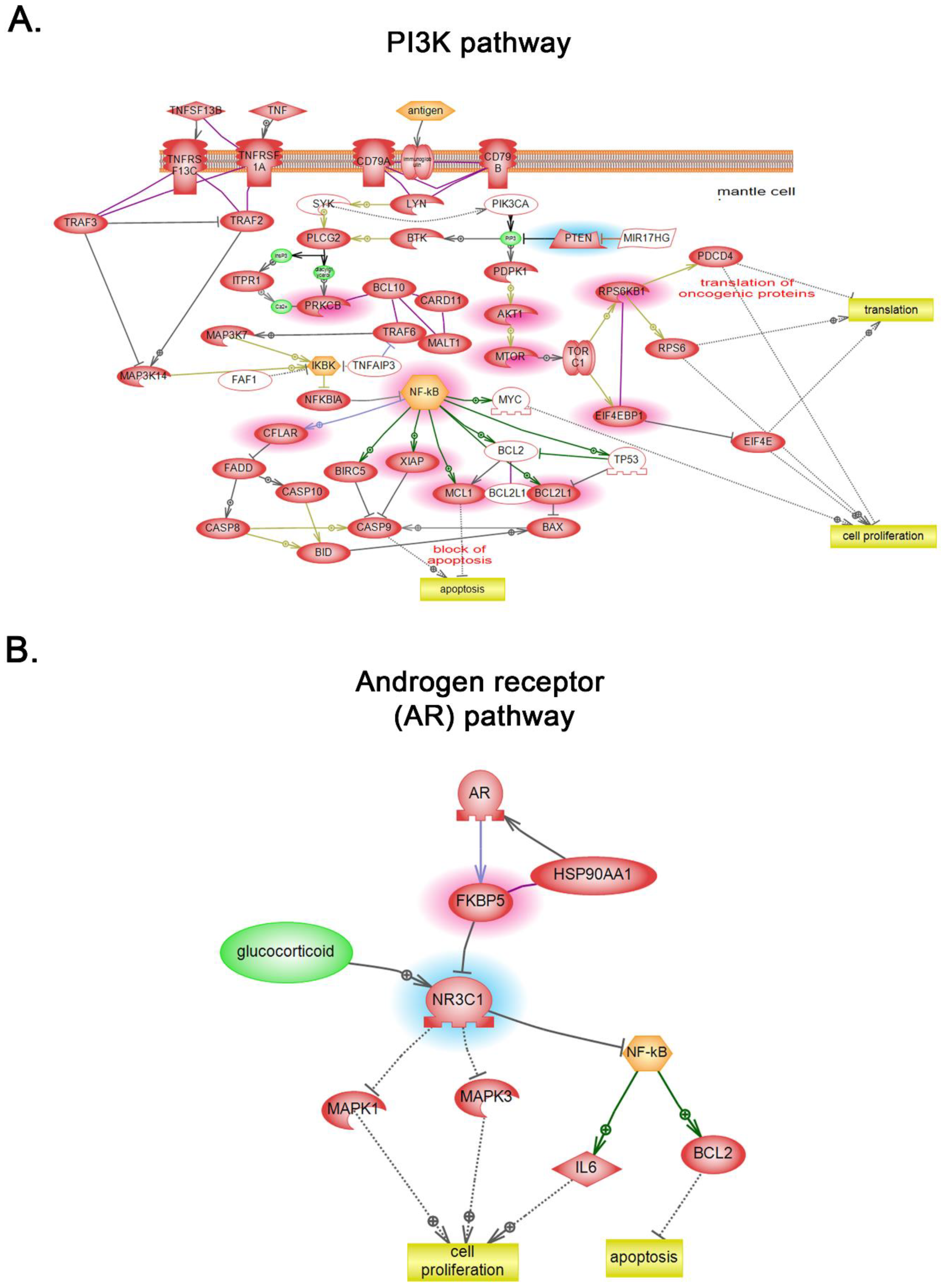
| Protein Accession Number | Identified Protein | Gene Name | Molecular Weight (Daltons) | LogFC | p-Value |
|---|---|---|---|---|---|
| P29477 | Nitric oxide synthase, inducible | Nos2 | 130,575 | Infinity | 0.0421 |
| Q4KMM3 | Oxidation resistance protein 1 | Oxr1 | 95,912 | Infinity | 0.0062 |
| Q8BH04 | Phosphoenolpyruvate carboxykinase (PEPCK), mitochondrial | Pck2 | 70,528 | Infinity | 0.0211 |
| Q60760 | Growth factor receptor-bound protein 10 | Grb10 | 70,585 | Infinity | 0.0005 |
| P24270 | Catalase | Cat | 59,795 | Infinity | 0.0370 |
| Q64669 | NAD(P)H dehydrogenase (quinone) 1 | Nqo1 | 30,960 | Infinity | 0.0007 |
| O88587 | Catechol O-methyltransferase | Comt | 29,486 | Infinity | 0.0139 |
| P62281 | 40S ribosomal protein S11 | Rps11 | 18,431 | Infinity | 0.0244 |
| P21981 | Protein-glutamine gamma-glutamyltransferase 2 | Tgm2 | 77,061 | 4.4671 | 0.0039 |
| Q9D1A2 | Cytosolic non-specific dipeptidase | Cndp2 | 52,767 | 3.6410 | 0.0159 |
| Q9DCX2 | ATP synthase subunit d, mitochondrial | Atp5h | 18,749 | 3.1880 | 0.0049 |
| P28063 | Proteasome subunit beta type-8 | Psmb8 | 30,260 | 3.1819 | 0.0287 |
| P35282 | Ras-related protein Rab-21 | Rab21 | 24,106 | 3.0182 | 0.0095 |
| P47738 | Aldehyde dehydrogenase, mitochondrial | Aldh2 | 56,538 | 2.3290 | 0.0005 |
| Q9JMH6 | Full = Thioredoxin reductase 1 | Txnrd1 | 67,084 | 2.2227 | 0.0183 |
| Q99NB9 | Splicing factor 3B subunit 1 | Sf3b1 | 145,816 | 2.1813 | 0.0045 |
| P47758 | Signal recognition particle receptor subunit beta | Srprb | 29,579 | 2.1686 | 0.0301 |
| Q62351 | Transferrin receptor protein 1 | Tfrc | 85,731 | 2.0240 | 0.0258 |
| Q64378 | Peptidyl-prolyl cis-trans isomerase FKBP5 | Fkbp5 | 50,966 | 1.8587 | 0.0311 |
| Q8VDN2 | Full = Sodium/potassium-transporting ATPase subunit alpha-1 | Atp1a1 | 112,982 | 1.8237 | 0.0261 |
| Q8R180 | ERO1-like protein alpha | Ero1a | 54,084 | 1.7824 | 0.0028 |
| P26443 | Glutamate dehydrogenase 1, mitochondrial | Glud1 | 61,337 | 1.7622 | 0.0313 |
| Q8VDM4 | 26S proteasome non-ATPase regulatory subunit 2 | Psmd2 | 100,203 | 1.3712 | 0.0190 |
| Q9CYA0 | Cysteine-rich with EGF-like domain protein 2 | Creld2 | 38,220 | 1.2856 | 0.0364 |
| P67778 | Prohibitin | Phb | 29,820 | 1.2844 | 0.0187 |
| Q9R0P3 | S-formylglutathione hydrolase | Esd | 31,320 | 1.2832 | 0.0021 |
| Q9DCT8 | Cysteine-rich protein 2 | Crip2 | 22,727 | 1.2703 | 0.0017 |
| O88342 | WD repeat-containing protein 1 | Wdr1 | 66,407 | 1.2169 | 0.0318 |
| P14131 | Full = 40S ribosomal protein S16 | Rps16 | 16,445 | 1.1228 | 0.0228 |
| Q61553 | Fascin | Fscn1 | 54,508 | 1.0726 | 0.0476 |
| P20152 | Vimentin | Vim | 53,688 | 1.0105 | 0.0004 |
| Q64727 | Vinculin | Vcl | 116,717 | 0.9370 | 0.0304 |
| P80317 | T-complex protein 1 subunit zeta | Cct6a | 58,004 | 0.9272 | 0.0335 |
| P17182 | Alpha-enolase | Eno1 | 47,141 | 0.8210 | 0.0364 |
| P60335 | Poly (rC)-binding protein 1 | Pcbp1 | 37,498 | 0.8126 | 0.0037 |
| P70670 (+1) | Nascent polypeptide-associated complex subunit alpha, muscle-specific form | Naca | 220,499 | 0.8122 | 0.0194 |
| Q922B2 | Aspartate–tRNA ligase, cytoplasmic | Dars | 57,147 | 0.8096 | 0.0454 |
| Q60605 | Myosin light polypeptide 6 | Myl6 | 16,930 | 0.7325 | 0.0474 |
| P48678 | Prelamin-A/C | Lmna | 74,238 | 0.7302 | 0.0132 |
| Q08288 | Full = Cell growth-regulating nucleolar protein | Lyar | 43,736 | 0.7127 | 0.0244 |
| P05064 | Fructose-bisphosphate aldolase A | Aldoa | 39,356 | 0.6559 | 0.0180 |
| Q9CZ13 | Cytochrome b-c1 complex subunit 1, mitochondrial | Uqcrc1 | 52,852 | 0.6106 | 0.0408 |
| P52480 | Full = Pyruvate kinase PKM | Pkm | 57,845 | 0.5844 | 0.0461 |
| Q8VDD5 | Myosin-9 | Myh9 | 226,372 | 0.4277 | 0.0164 |
| P97384 | Annexin A11 | Anxa11 | 54,079 | 0.3144 | 0.0315 |
| P68254 | 14-3-3 protein theta | Ywhaq | 27,778 | −0.1887 | 0.0445 |
| P68372 | Tubulin beta-4B chain | Tubb4b | 49,831 | −0.2529 | 0.0332 |
| Q02053 | Ubiquitin-like modifier-activating enzyme 1 | Uba1 | 117,809 | −0.4917 | 0.0040 |
| Q8R1B4 | Eukaryotic translation initiation factor 3 subunit C | Eif3c | 105,531 | −0.6056 | 0.0123 |
| P50543 | Protein S100-A11 | S100a11 | 11,083 | −0.6181 | 0.0341 |
| Q9D819 | Inorganic pyrophosphatase | Ppa1 | 32,667 | −0.6647 | 0.0186 |
| P18760 | Cofilin-1 | Cfl1 | 18,560 | −0.7070 | 0.0359 |
| P27546 | Microtubule-associated protein 4 | Map4 | 117,429 | −0.8789 | 0.0044 |
| Q8C1B7 | Septin-11 | Sept11 | 49,695 | −0.8938 | 0.0365 |
| P30416 | Peptidyl-prolyl cis-trans isomerase FKBP4 | Fkbp4 | 51,572 | −0.9705 | 0.0146 |
| Q99MN1 | Lysine–tRNA ligase | Kars | 67,840 | −1.0337 | 0.0008 |
| P48962 | ADP/ATP translocase 1 | Slc25a4 | 32,904 | −1.0449 | 0.0264 |
| P10107 | Annexin A1 | Anxa1 | 38,734 | −1.0643 | 0.0202 |
| P13020 | Gelsolin | Gsn | 85,942 | −1.0647 | 0.0162 |
| Q60932 | Voltage-dependent anion-selective channel protein 1 | Vdac1 | 32,351 | −1.2973 | 0.0009 |
| Q60864 | Stress-induced-phosphoprotein 1 | Stip1 | 62,582 | −1.3133 | 0.0021 |
| P62827 | GTP-binding nuclear protein Ran | Ran | 24,423 | −1.3401 | 0.0325 |
| P62830 | 60S ribosomal protein L23 | Rpl23 | 14,865 | −1.3537 | 0.0023 |
| Q76MZ3 | Serine/threonine-protein phosphatase 2A 65 kDa regulatory subunit A alpha isoform | Ppp2r1a | 65,323 | −1.3762 | 0.0235 |
| P17879 | Heat shock 70 kDa protein 1B | Hspa1b | 70,176 | -1.3879 | 0.0209 |
| O55131 | Septin-7 | Sept7 | 50,550 | −1.4336 | 0.0409 |
| Q8BGQ7 | Alanine–tRNA ligase, cytoplasmic | Aars | 106,909 | −1.4824 | 0.0113 |
| Q99K85 | Phosphoserine aminotransferase | Psat1 | 40,473 | −1.4994 | 0.0014 |
| Q6IRU2 | Tropomyosin alpha-4 chain | Tpm4 | 28,468 | −1.5363 | 0.0019 |
| P62814 | V-type proton ATPase subunit B, brain isoform | Atp6v1b2 | 56,551 | −1.5772 | 0.0284 |
| P99029 | Peroxiredoxin-5, mitochondrial | Prdx5 | 21,897 | −1.7034 | 0.0397 |
| Q9Z110 | Delta-1-pyrroline-5-carboxylate synthase | Aldh18a1 | 87,266 | −1.7114 | 0.0488 |
| O70400 | PDZ and LIM domain protein 1 | Pdlim1 | 35,774 | −1.7682 | 0.0055 |
| P08003 | Protein disulfide-isomerase A4 | Pdia4 | 71,982 | −1.7998 | 0.0218 |
| Q78PY7 | Staphylococcal nuclease domain-containing protein 1 | Snd1 | 102,088 | −1.9226 | 0.0089 |
| Q3THE2 (+1) | Myosin regulatory light chain 12B | Myl12b | 19,779 | −1.9663 | 0.0019 |
| Q9DAW9 | Calponin-3 | Cnn3 | 36,429 | −1.9714 | 0.0138 |
| P47226 | Testin | Tes | 47,983 | −2.1001 | 0.0061 |
| P19096 | Fatty acid synthase | Fasn | 272,428 | −2.1356 | 0.0143 |
| Q8VH51 | RNA-binding protein 39 | Rbm39 | 59,407 | −2.1700 | 0.0432 |
| P16546 | Spectrin alpha chain, non-erythrocytic 1 | Sptan1 | 284,597 | −2.1906 | 0.0004 |
| O55023 | Inositol monophosphatase 1 | Impa1 | 30,436 | −2.2878 | 0.0041 |
| P34022 | Ran-specific GTPase-activating protein | Ranbp1 | 23,596 | −2.3426 | 0.0192 |
| Q9CZY3 | Ubiquitin-conjugating enzyme E2 variant 1 | Ube2v1 | 16,355 | −2.5164 | 0.0385 |
| Q9JKF1 | Ras GTPase-activating-like protein IQGAP1 | Iqgap1 | 188,742 | −2.5447 | 0.0001 |
| Q9EQH3 | Vacuolar protein sorting-associated protein 35 | Vps35 | 91,713 | −2.6401 | 0.0140 |
| Q69ZN7 | Myoferlin | Myof | 233,324 | −2.7480 | 0.0041 |
| Q00PI9 | Heterogeneous nuclear ribonucleoprotein U-like protein 2 | Hnrnpul2 | 84,940 | −infinity | 0.0466 |
| Q6P1B1 | Xaa-Pro aminopeptidase 1 | Xpnpep1 | 69,591 | −infinity | 0.0029 |
| Q8JZK9 | Hydroxymethylglutaryl-CoA synthase, cytoplasmic | Hmgcs1 | 57,569 | −infinity | 0.0493 |
| Q8VI94 | 2′-5′-oligoadenylate synthase-like protein 1 | Oasl1 | 59,088 | −infinity | 0.0024 |
| Q64282 | Interferon-induced protein with tetratricopeptide repeats 1 | Ifit1 | 53,737 | −infinity | 0.0054 |
| Q8CAY6 | Acetyl-CoA acetyltransferase, cytosolic | Acat2 | 41,298 | −infinity | 0.0406 |
| Q920E5 | Farnesyl pyrophosphate synthase | Fdps | 40,582 | −infinity | 0.0080 |
| Q99JW5 | Epithelial cell adhesion molecule | Epcam | 35,019 | −infinity | 0.0027 |
| P70677 | Caspase-3 | Casp3 | 31,475 | −infinity | 0.0054 |
| Q62393 | Tumor protein D52 | Tpd52 | 24,313 | −infinity | 0.0036 |
| P61967 | AP-1 complex subunit sigma-1A | Ap1s1 | 18,733 | −infinity | 0.0498 |
| Q9CR51 | V-type proton ATPase subunit G 1 | Atp6v1g1 | 13,724 | −infinity | 0.0430 |
© 2020 by the authors. Licensee MDPI, Basel, Switzerland. This article is an open access article distributed under the terms and conditions of the Creative Commons Attribution (CC BY) license (http://creativecommons.org/licenses/by/4.0/).
Share and Cite
Bahmad, H.F.; Peng, W.; Zhu, R.; Ballout, F.; Monzer, A.; Elajami, M.K.; Kobeissy, F.; Abou-Kheir, W.; Mechref, Y. Protein Expression Analysis of an In Vitro Murine Model of Prostate Cancer Progression: Towards Identification of High-Potential Therapeutic Targets. J. Pers. Med. 2020, 10, 83. https://doi.org/10.3390/jpm10030083
Bahmad HF, Peng W, Zhu R, Ballout F, Monzer A, Elajami MK, Kobeissy F, Abou-Kheir W, Mechref Y. Protein Expression Analysis of an In Vitro Murine Model of Prostate Cancer Progression: Towards Identification of High-Potential Therapeutic Targets. Journal of Personalized Medicine. 2020; 10(3):83. https://doi.org/10.3390/jpm10030083
Chicago/Turabian StyleBahmad, Hisham F., Wenjing Peng, Rui Zhu, Farah Ballout, Alissar Monzer, Mohamad K. Elajami, Firas Kobeissy, Wassim Abou-Kheir, and Yehia Mechref. 2020. "Protein Expression Analysis of an In Vitro Murine Model of Prostate Cancer Progression: Towards Identification of High-Potential Therapeutic Targets" Journal of Personalized Medicine 10, no. 3: 83. https://doi.org/10.3390/jpm10030083
APA StyleBahmad, H. F., Peng, W., Zhu, R., Ballout, F., Monzer, A., Elajami, M. K., Kobeissy, F., Abou-Kheir, W., & Mechref, Y. (2020). Protein Expression Analysis of an In Vitro Murine Model of Prostate Cancer Progression: Towards Identification of High-Potential Therapeutic Targets. Journal of Personalized Medicine, 10(3), 83. https://doi.org/10.3390/jpm10030083









